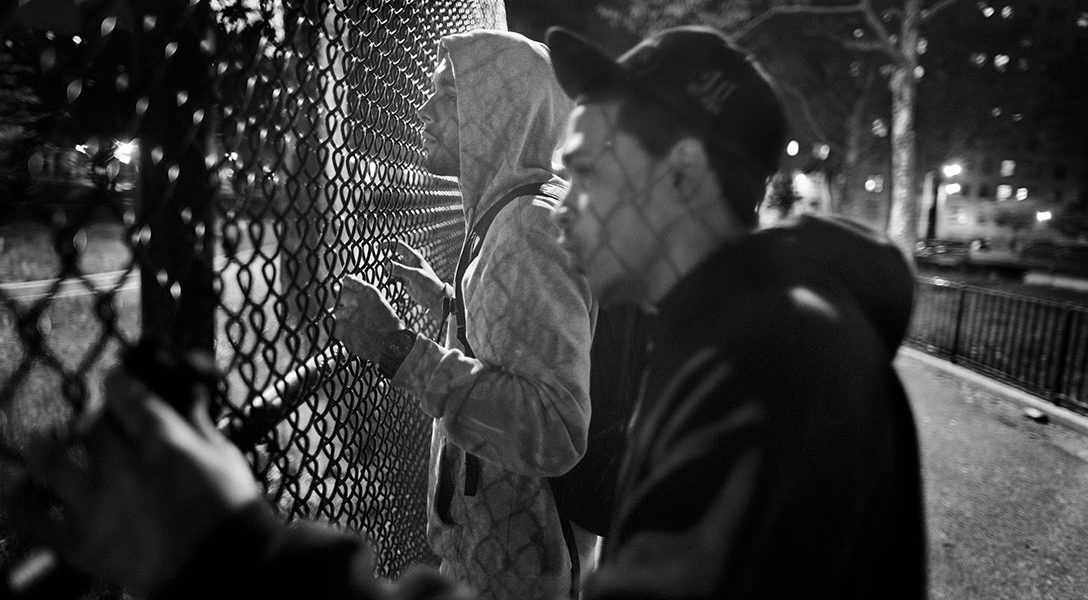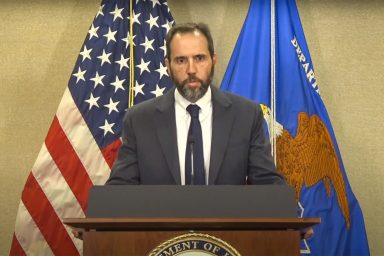Not only was Michael Bloomberg’s “stop and frisk” policy wrong when he was mayor of New York City, his justification of it was just as bad.
Presidential candidate Michael Bloomberg has been challenged over comments he made about New York’s controversial “stop and frisk” policies while he was mayor. He said that “male minorities” aged 15 to 25 are responsible for “95 percent of murders.”
Author Anne Kim argues this comment is wrong, and harmful to the disconnected young Americans she writes about in her new book, Abandoned. Dropouts, unemployed youth, juvenile offenders, and “emancipated” foster kids are largely invisible in urban and rural communities, and fall through the gaps in what is left of the US’s social safety net.
Kim notes that young people from middle class families often get family support and second chances during the transition to adulthood, while children of poverty face many barriers to education, jobs, and stable housing.
Anne Kim is a contributing editor at Washington Monthly and author of Abandoned: America’s Lost Youth and the Crisis of Disconnection.



Click HERE to Download Mp3
Full Text Transcript:
As a service to our readers, we provide transcripts with our podcasts. We try to ensure that these transcripts do not include errors. However, due to time constraints, we are not always able to proofread them as closely as we would like. Should you spot any errors, we’d be grateful if you would notify us.
| Peter B. Collins: | Welcome to another Radio WhoWhatWhy podcast. In San Francisco, I’m Peter B. Collins. |
| Peter B. Collins: | Billionaire Mike Bloomberg’s entry into the presidential campaign has highlighted his embrace of these stop-and-frisk policies in New York while he was mayor, and his continued defense of those measures. And he targeted primarily young adults who were brown and black, and he has been quoted recently with some of the comments that he made that are alarming in many respects. |
| Peter B. Collins: | Anne Kim joins me today. She has a journalism degree, a law degree. She is a contributing editor at Washington Monthly and her new book, I think, is very important and highlights a group of people that many Americans ignore or have just completely forgotten about. The book is called Abandoned: America’s Lost Youth and the Crisis of Disconnection. Anne, thanks for joining us today. |
| Anne Kim: | Thank you so much for having me, Peter. |
| Peter B. Collins: | What drew your interest in this group of people, roughly age 16 to 25, sometimes described as a NEET? Explain to our listeners what the acronym N E E T refers to, please. |
| Anne Kim: | Yes. NEET is a term that’s actually used in the United Kingdom. It stands for Not in Employment Education or Training. And we, the United States, is among the few countries in the world that does not monitor, keep track of the share of young adults who are not in school and not working. The United States in 2017, which is the latest numbers that we have that tells you how behind we are on monitoring this problem, there were 4.5 million young adults ages 16 to 24 not in school, not working. During the great recession, that number was close to 7 million. We’re talking about 11.5% of all young people today. |
| Peter B. Collins: | And they’re distributed all across the country, right about the plight of a rural people of this age and also the complex problems faced by those who live in an urban setting. And it appears that while we focus a lot now on early childhood, there’s a lot of attention to access to higher education on a broad basis. But have we kind of allowed this group to fall between the cracks, in your view? |
| Anne Kim: | We’ve completely ignored young adulthood as a phenomenon. And in all honesty, the phenomenon of young adulthood is kind of recent. The runway to adult independence has lengthened, I would say, in the last generation or so. It wasn’t always the case that you had to have more education. It wasn’t always the case that you had to have the right kind of education and that you needed more parental support. 20 years ago, we’d have called this failure to launch, but now I think a lot of middle class and upper middle class families just take it as a given that they’re going to need to support their children into the early 20s. Now, the problem is that governmental supports and other social supports for young people who do not have parents behind them or communities behind them, fall away. And this is what I’m referring to by abandonment. For them, life ends at 18 if not sooner. And they are cut off from opportunities for education and for employment in really tragic ways. |
| Peter B. Collins: | And we have people, I referenced Mayor Bloomberg, who has entered the democratic primary, and it’s caused a lot of scrutiny of his comments in defense of the stop-and-frisk policies in New York city while he was mayor. And one quote that has been just resonating and also gone viral came from a comment that he made at the Aspen Institute in 2015. He said, “95% of murders, murders and murder victims, fit one M.O. You can just take a description, Xerox it, and pass it around to all the cops. They are male, minority, 16 to 25. That’s true in New York. That’s true in virtually every city and that’s where the real crime is. You’ve got to get the guns out of the hands of people that are getting killed.” How did you react to that remark, Anne Kim? |
| Anne Kim: | So I will preface my response with one thing in his defense to be fair to mayor Bloomberg. In 2011, he did launch a very ambitious initiative, $130 million to invest in educational and job training opportunities that are aimed at young black and Latino men in New York City and he did put some of his own money behind this. And he got George Soros to help him and he really made an effort. Unfortunately, there are some comments surfacing from how he promoted this effort that echo some of the less than sensitive approach to this population that you just quoted there. More broadly, the stereotyping that is evident in Bloomberg’s quote is a big reason why young adults ages 16 to 24 have been neglected and abandoned for so long. There is this racialized stereotype on the one hand, and then there’s another narrative around personal choice, and poor life choices, and personal responsibility. |
| Anne Kim: | Those two things together, really, I think, work to justify a lack of investment and the lack of caring about young adults who are actually facing very serious structural obstacles to getting ahead. And that is one of the things I really want to make clear in the book, and I sprinkled the narrative with stories of young people to really demonstrate that these are not young people who’ve made poor life choices. In fact, they’re doing the best they can under the circumstances given to them. And things like what Mayor Bloomberg has said reinforce negativity around a population that really needs help and wants to help and really wants to plead. |
| Peter B. Collins: | Well, I think it also promotes ignorance. It promotes a generalization that is not borne out. And I want to commend your book to our listeners because you cover this topic with references to academic studies and detailed psychological studies of this group, but it’s a very accessible book and you did the hard work for us, to collect the data and you present it in a way that is easy to absorb. But much of what you report in the book directly contradicts the false impression created by Mike Bloomberg’s comment and I don’t choose to single him out. I think that his comment reflects a kind of generalized write-off of certain segments of society that is often engaged in by those who are entitled and in power. |
| Anne Kim: | That’s absolutely right. I mean, one of the phenomenon that I’ve noticed, and I do allude to it in the book, is that if you are a middle class, upper middle class, we’ve begun infantilizing young adults. We welcome them back into our basements when they turn 22, make sure they get internship, that first job, connect them to the people in our networks. There’s a lot of helicoptering that goes on even into the mid-twenties and beyond. But then there’s this double standard. If you are a young person of color, if you’re a young person of little means, then you are adultified. You’re 16 years old? Okay, then you have to go to an adult prison for a mistake you might commit. |
| Anne Kim: | So there’s a lot of injustice that flows from that double standard. You alluded to the brain science. There is a much more nuanced understanding now of what goes on in a child’s brain up to age 25. We all know at this point that early childhood really matters and you have those neural connections that are being formed by age three, which is why we have the baby Einstein toys and all of that. But as it turns out, there is a new period of plasticity of the brain when there’s a lot of learning that goes on, physical connections that take place between the frontal lobes of the brain where reasoning, critical analysis, judgment, all that, those connections happen in the late adolescent years all the way to age 25. There’s a physiological reason why young adults act the way they do, as any parent of a teenager knows. And so that means it’s the physiological reason for why everyone in this age group deserves a second chance. People make mistakes because they are literally still developing. |
| Peter B. Collins: | And you spent a lot of time using the term “disconnected” to describe this group of people. And you alluded earlier, when I asked you to explain the NEET acronym, that these people fall outside a lot of collected data. Many of them have never held a job, so they don’t show up as unemployed or out of the workforce. Many of them have left school for one reason or another, so they don’t show up in an educational database. And many of them don’t even have driver’s licenses. So they really are almost invisible in our big data world today. |
| Anne Kim: | That’s right. The most reliable data we have come from nonprofit organizations who have made it their mission to document this population. And the book relies heavily in particular on the Social Science Research Council, their Measure of America project, where they have combed through census data to try to get a portrait over time of who this disconnected population is. But you’re absolutely right. To be disconnected means to be invisible, to be not counted. We have pretty good, really, estimation, speculation of what and why, and this book tries to synthesize the causes that are the most obvious, particularly from a public policy standpoint, that are the engines of disconnection. But there’s a lot more that we need to know. And we’re in a census year. This is the 2020 census year. This is the year when, maybe, the Census Bureau should start thinking about, “Okay, this is the population deserving attention, that should be counted, and we need to measure and monitor in the same way that other countries around the world are measuring and monitoring this population and investing in them.” |
| Peter B. Collins: | And Anne, to what extent are the twin crises of methamphetamine and opioids apparent in this segment of the population? |
| Anne Kim: | I would actually say that there are probably larger engines of disconnection than the meth and opioid crises, which might strike a slightly older population. If you’re going to go at the problem of connecting and reconnecting young people before they drop out, I would start with the criminal justice system, the foster care system, the educational system first. Fixing those three things will prevent young people from later falling into more problems with substance abuse of all kinds. But there are some foundational public policy drivers of disconnection that really need to be grappled with first. |
| Peter B. Collins: | Now, there is quite a bit of attention right now to reform of the so-called juvenile justice system here in California. We are shutting down juvenile detention centers. And it’s not clear that there’s a real replacement. And so I feel like this is in flux, and again, not getting the level of attention deserved. And certainly, there are juvenile offenders who need to be treated as such, but there are many who are in contact with the law because of poverty, because of a broken home, because of drug use by parents, or incarceration of one or more parent. And so these complex issues, in many ways, are being addressed by reducing some of the known harms of incarceration of young adults. But my impression and, and please tell us yours, you’re much more engaged on this, is that we’re not devoting enough resources and enough pure research to trying to come up with innovative ways to deal with this population. |
| Anne Kim: | That’s right. First of all, I applaud California for taking steps to reduce the number of young people who are sent to juvenile detention facilities. It’s absolutely the case that detention, particularly in adult facilities, absolutely catastrophic to the prospects of a young person. It’s fairly obvious what those consequences are, but chief among them is the lack of any educational services. Only 7% of facilities will provide any services to help young people get education or training for job, that’s according to the Justice Policy Institute. Young people are also more likely to be assaulted while they’re incarcerated, and so they are also then more likely to be re-offenders when they come out. I came across this very shocking number, which is that 70, 80 percent of young people who are incarcerated end up re-incarcerated within two to three years. And of course, you’re talking about lifelong impact after that. |
| Anne Kim: | So that’s a very important step that California is taking. But you’re right about what is the alternative. In New York, there is a phenomenal nonprofit called CASES, which is working with the court system as a diversion program. Young people are essentially sentenced to go to CASES in lieu of incarceration. But once they get there, as part of their “sentence”, is training and education, and support. They get mental health services. And this program is working. I met several young people who had actually graduated from the program but kept coming back to meet with their case workers and to meet with their kind of surrogate family CASES because this organization has really stepped in to provide the mentorship and support along the way that they really needed. If we can invest in that, I think that would be an ideal alternative to the juvenile detention facilities that have become the default for too many young people for too long. |
| Peter B. Collins: | One of the aggravating factors as well is suspension and expulsion from high school, which creates a pool of individuals for the group that you’re describing as abandoned. And there’s kind of a conundrum now. Because of school shootings, we’re seeing more deployment of armed law enforcement officers on high school campuses. This, in turn, I believe, leads to a criminalization of infractions that previously would have been dealt with in an administrative fashion at the school. |
| Peter B. Collins: | And here in California, I want to command our most recent governor, Jerry Brown, because he was initially skeptical of measures to reduce the use of suspension and expulsion as a disciplinary measure in California high schools. But when he saw the data, he did turn around, he first vetoed a bill and then two years later he, he signed a very similar piece of legislation. And I suppose it strikes some people as counterintuitive, but what is your view of this high-school-to-prison pipeline and the extent to which people are becoming aware of it and looking for alternatives? |
| Anne Kim: | Oh, I applaud California as well, and Governor Brown, for this. It is a completely self-defeating policy to expel or suspend students who are in trouble. Because what happens, they become disconnected and then they lose any connection with the support services that could potentially turn themselves, turn their lives around. And it only spirals downward from there. And of course there’s a lot of research now coming out, too, on the racial inequities in terms of suspensions and expulsions as well. So you are reinforcing the racially disparate impacts of these harsh disciplinary policies so long as these policies persist. So the fact that there is some enlightenment in these quarters is really good news because it means… If you’re a young person who is acting out in high school, you need more help, not less. And so it is completely counterproductive to send this young child out of school where they’re only going to get into even more trouble than they have already. |
| Anne Kim: | But again, it’s a question of providing enough resources for the support. Unfortunately, I think what’s happened is that it benefits the school’s test scores and other measures of accountability if they’re able to narrow the pool of their students to benefit their highest performers. The incentives aren’t there necessarily for the schools to invest in students who need a little bit more help to turn them around. That incentive structure is something that we still need to fix them to work on. |
| Peter B. Collins: | And then, Kim, is the disconnected group that you write about in your book Abandoned, have they recovered from the recession of 2008 at the same rate as the rest of us? |
| Anne Kim: | No. As I had mentioned at the very start of this conversation, the number of disconnected young people was closer to 7 million at the height of recession. So definitely, there has been some progress going on. But keep in mind that we have been hearing from our president that we have the best economy in decades, the best economy ever. The fact that 1 in 9 young people is out of school and out of work, in what’s the best economy in decades, should give us all pause. There’s something very wrong when you have 4.5 million working-age young adults who have no opportunities to get ahead in life. |
| Peter B. Collins: | Well, and I hate to extend excessive fairness to Trump, but when you’re a candidate, you talk about the entire workforce, and when you are in office, you talk about low unemployment figures. And there’s a big gap between the two of them, but it’s pretty common politically to use that practice, I would say. Nevertheless, this is a group that needs to be addressed with greater access to job training, and recognition that not everybody goes to college, and that we need to embrace and support portions of the labor force who will perform jobs that don’t require a higher education. Is there a discriminatory element in that range, if you will? |
| Anne Kim: | Let me address the first part of your comment. The unemployment rate, just to keep in mind, is a number that is based upon people who say they are looking for work. It doesn’t take into account the number of people who have dropped out and say they are no longer looking for employment. So when you look at the employment to population ratio, which is the share of people who are actually in the workforce, that has actually been still declining. And it’s particularly high among young adults. So that 3.5%,
3.6 % unemployment rate isn’t really a fair indication of who is working. And the national unemployment rate also doesn’t tell you where the pockets of prosperity are versus the pockets of despair, so to speak. |
| Anne Kim: | One thing that’s come clear in the research that’s laid out in the book is that zip code and place really matter. Where you are, Peter, in San Francisco, there’s prosperity all around you. But when you just head out of the San Francisco Metro area and head to, say, Riverside, the disconnection rate there is 15%. In Mendocino County it’s 18.4%. It’s close to 1 out of 5 young adults who are out of school and out of work. So place really matters and zip code really matters. |
| Anne Kim: | On the question of access to college and opportunities for all, I think we do need to become much more ecumenical about what we mean by higher education opportunities. Apprenticeships are beginning to become a little bit more popular, but they have fallen out of style for a while. The trades are facing enormous shortages, actually. We don’t have enough electricians. But schools have become much more focused on academic achievement in preparation for 4-year college track and the 4-year college track has been, has turned into kind of this brass ring that everybody must reach for. And if you don’t get to college, you’re a failure. That I think is the wrong way to think about a young person’s success. There are many paths. They do require some sort of education after high school, that much is clear. But we need to become much more ecumenical about what those paths might look like and how you combine school and work in such a way that certificates, credentials, and alternative forms of higher education are recognized as equally valid and valuable in the workplace. |
| Peter B. Collins: | Well, and one of the anecdotes that you share in your book is about the progress that has been shown. Once in McAllen, Texas, they opened South Texas College and that’s a community college in an area that didn’t have one there. There was only the University of Texas-Pan American and so the entire population really didn’t have easy access. And you describe programs there that really are educating people to workforce opportunities in that area. Tell us a little more about that, please. |
| Anne Kim: | Yes. McAllen,Texas, I think people have heard of McAllen in a much more negative light. That’s the place where the family separations are happening. But there is a hidden story there of the turnaround of the community. Now, this is a border town that was really hit hard. It used to grow citrus, and then all of that went away with a series of hard freezes in the ’90s and the unemployment rate was over 60%, is what I was told. Really dire circumstances. What happened there, and as you mentioned, there was no higher education opportunities. Texas-Pan was there but it shut down and there was literally no community college, no institution for higher education. The community is tight knit enough and small enough that there is an alliance of educational leaders, business leaders, community leaders that got together and they had created this really innovative kind of cradle-to-college pipeline where businesses, the community college, and the K-12 education system are all working together so that young people who are going through the system know that there is going to be this kind of need for this type of job and their education is relevant to them. |
| Anne Kim: | The really remarkable superintendent there named Daniel King, who brought early college high schools to this area as well, so their kids are graduating high school with an associate’s degree, and more often than not, a job. He was telling me about, 20-year-olds who were already in law school because they had saved two years of tuition and time finishing two years of college while they were in high school and all geared up to finish and get their bachelor’s degree by the time they were 20. It’s really a remarkable story. And this is a population that’s 85% Hispanic and mostly low-income as well. So I included the story as an example of how a community that seemed to have been really down in its heels can really transform itself and set a model for the rest of the country, and how you can take a place that seems to have no opportunity, and really make it bloom. |
| Peter B. Collins: | You cite King’s data that 370 of 1900 students who’ve graduated also earned associate’s degrees, saving themselves two years worth of tuition. Not only that, they’re on a springboard to gain access to a state level college or university. Isn’t that correct? |
| Anne Kim: | That is correct. And the interesting thing about this strategy is that by offering his high school students college during high school, he actually also eliminated the dropout problem. Now, a main driver of disengagement from high school is when the kids say that they don’t find their education relevant by… What he told me was, when students are in class getting college credit for free at the same time that they’re in high school, they have much more incentive to stay there and to graduate. So he was able to virtually eliminate the high school dropout problem in his school district by offering students college as juniors and seniors. And that also accounts for his remarkable numbers. |
| Peter B. Collins: | And in the final chapter of your book, you offer 7 different ideas for ending disconnection with this critical young population. And I’d like to focus on number 6. We talked about the criminal justice system, but you also focus on disconnection in the foster care system. And what happens when a young person who’s in the foster system reaches the age where foster care ends? It appears that many of them are just kind of treated like a prison release. 200 bucks and a bus ticket. |
| Anne Kim: | The ironic word that the government uses or the states use when they, when a young person ages out of foster care is “emancipation”. It is a cruel word to describe what happens to a young person who ages out. Technically there’s supposed to be a “transition plan”, but the reality is more like abandonment, more of a spigot that turns off the day that this young person turns 18 or in some states, the day it turns 21. There’s no support for college education. Most states don’t waive tuition off for college if they want to pursue higher education. There are very few transitional services. So the outcomes are absolutely horrific. One-third of the 20,000 or so young people who age out of foster care are going to end up homeless, one-third end up incarcerated, only about 8% get a two-year degree or a four-year degree. Fewer than half will have a job by the age of 26. These are unfathomably tragic consequences. And this is from a system whose purpose is supposed to be protecting child welfare and to have those kinds of outcomes from a child welfare system is unspeakably tragic. |
| Peter B. Collins: | And are there any states that are aware of this and, in your view, taking steps to address it? |
| Anne Kim: | There are some states, I don’t have the list off the top of my head, who have made inroads, at least in providing waivers for in-state college tuition for foster youth. And there have been more investments from the federal level, John Chafee Independence, foster youth independence act, that have made some investments. But clearly there is a need for a lot more support earlier on and not when a young person is turning 18 and about to age out. It’s a much larger problem that many other authors have written about on all the problems that are wrong with the foster care system. It is a system that needs reform from top to bottom, I think, if we’re going to get the outcomes that we want. |
| Peter B. Collins: | Anne Kim, I want to thank you for a very powerful book. There’s a lot more in the book. Is there anything I didn’t ask you about that you’d like to mention as we wrap up? |
| Anne Kim: | This has been fantastic, Peter. Thank you so much for your questions. |
| Peter B. Collins: | All right. The book is called Abandoned, subtitled America’s Lost Youth and the Crisis of Disconnection. Our guest, Anne Kim. Thank you very much, Anne. |
| Anne Kim: | Thank you. |
| Peter B. Collins: | Thanks for listening to this Radio WhoWhatWhy podcast with author Anne Kim. Send your comments to Peter at peter@peterbcollins.com. And if you’re able, consider making a contribution to support the investigative journalists here at WhoWhatWhy. |
Related front page panorama photo credit: Adapted by WhoWhatWhy from Bob Jagendorf / Flickr (CC BY-NC 2.0).



